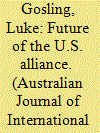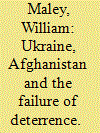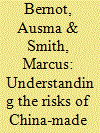|
|
|
Sort Order |
|
|
|
Items / Page
|
|
|
|
|
|
|
| Srl | Item |
| 1 |
ID:
192083


|
|
|
|
|
| Summary/Abstract |
One of the most successful defence pacts in history, Australia’s alliance with America is becoming ever more central to our strategic policy. This is a bipartisan trend that has been supported by previous governments, including in the Morrison government’s 2020 Defence Strategic Update, and is being implemented by the Albanese government, as confirmed in its 2023 Defence Strategic Review. At the same time, successive U.S. administrations have refocussed on the Indo-Pacific despite competing strategic priorities in other regions, including the Ukraine war. This has led to Australia and America pursuing a policy of deeper integration of their armed forces at the operational and strategic levels. This is most visible in northern Australia, whose value to Australian and allied defence planning is increasing for geopolitical reasons. Building on the Marine rotational force in Darwin announced in President Obama’s pivot to Asia, U.S. force posture initiatives are upgrading northern Australian defence infrastructure and deploying additional forces for exercises and contingency planning at a time when Australia is also investing in its northern bases. While cutting-edge capabilities such as SSN-AUKUS submarines will boost Australia’s strategic contribution to the alliance, its strength lies in the solid public support it enjoys.
|
|
|
|
|
|
|
|
|
|
|
|
|
|
|
|
| 2 |
ID:
192080


|
|
|
|
|
| Summary/Abstract |
This article examines Australian attitudes towards foreign aid and the intersection of these attitudes with broader debates around the purpose and level of the aid program. Drawing on surveys conducted over six decades, we show that the public broadly supports the principle of foreign aid, but are much less supportive of aid expenditure, especially judged against other areas of government spending. Using the 2022 Lowy Poll, we test four hypotheses to explain public support for foreign aid. The results show that both values and interests shape the public’s views of foreign aid spending. The challenge for policymakers is to craft messages about foreign aid which present aid expenditure as being relevant to both the values and interests relevant to the lives of everyday Australians.
|
|
|
|
|
|
|
|
|
|
|
|
|
|
|
|
| 3 |
ID:
192086


|
|
|
|
|
| Summary/Abstract |
Since early 2023, China has sought to play a more active crisis resolution role in the Russia-Ukraine war, marking a shift in Chinese behaviour on the conflict. What explains China’s pursuit of this role, an agenda that has been described as a ‘fool’s errand,’ not least because of the seeming difficulties of real peace between Kyiv and Moscow without one side capitulating to the other? One interpretation is that China’s behaviour is part of a broader trend of ambitions to play a bigger role in addressing global hotspots and project itself as a responsible power. It parallels Beijing’s involvement in brokering the Saudi-Iran rapprochement as well as attempts to mediate in the Israeli-Palestinian conflict. Yet, such ambitions are only part of the story. There are more contingent considerations behind the subtle but distinct change in Chinese positioning on the war. Far from being a ‘fool’s errand,’ Beijing’s peacemaker posturing is borne out of calculations taken to minimise risks to Chinese interests as a consequence of the war. Taking into account documentary sources and views from China, this article unpacks those calculations to provide a fuller explanation behind the shift in Chinese behaviour.
|
|
|
|
|
|
|
|
|
|
|
|
|
|
|
|
| 4 |
ID:
192081


|
|
|
|
|
| Summary/Abstract |
This article examines how middle powers develop their strategies for influencing other members of international society. This research is important as the literature on middle powers assumes that they possess significant persuasive power, yet does not explain how such persuasive capabilities are developed. This research applies the legitimation strategies framework to the case of Indonesia’s promotion of the ASEAN Outlook on the Indo-Pacific (AOIP). It argues that Indonesia sought to convince ASEAN countries, China, and the United States of the value of its preferred vision of the Indo-Pacific by articulating multiple rhetorics that appealed to the pre-existing interests and beliefs of the target audience. Before the ASEAN audience, Indonesia claimed that its vision was compatible with the principles of non-interference and regional economic development. To influence the United States, Indonesia held that its regional vision would support a rule-based order. To convince China, Indonesia maintained that its vision would create an inclusive regional order. This article, therefore, shows that middle powers seek to develop their persuasive capabilities through enunciations that appeal to the beliefs and interests of multiple audiences simultaneously.
|
|
|
|
|
|
|
|
|
|
|
|
|
|
|
|
| 5 |
ID:
192085


|
|
|
|
|
| Summary/Abstract |
This commentary reflects on the 3-pillar strategy for the implementation of the R2P, put forward by the UN Secretary-General in 2009. It outlines three problems with the 3-pillar strategy. First, fear of pillar 3 undermines support for R2P in its entirety; second, the 3-pillar strategy puts the emphasis on what the international community can do to States if they fail, rather than what all States should do all the time; and third, the 3-pillar approach assumes for the most part that where atrocities are being committed, either the territorial State or non-State actors are to blame.
|
|
|
|
|
|
|
|
|
|
|
|
|
|
|
|
| 6 |
ID:
192084


|
|
|
|
|
| Summary/Abstract |
Russia’s 2014 seizure of the Crimean Peninsula in Ukraine highlighted the limitations of a ‘rules-based’ international order in protecting a state’s territorial integrity in the face of threats to international peace and security resulting from the actions of a permanent member of the United Nations Security Council. With the capacity to veto any Security Council resolution authorising ‘enforcement action’ under Article 42 of the United Nations Charter, Russian leaders only had to fear the exercise under Article 51 of Ukraine’s inherent right of individual or collective self-defence. But Ukraine was in no position to drive Russian forces from Crimea unless supported by a great power such as the United States, and as Lawrence Freedman put it, ‘President Obama made it clear that he saw no circumstances in which the United States would use armed force in connection with this crisis’ (Freedman Citation2019, 106). The focus of the international response would instead be on extended deterrence of future Russian aggression.
|
|
|
|
|
|
|
|
|
|
|
|
|
|
|
|
| 7 |
ID:
192082


|
|
|
|
|
| Summary/Abstract |
In the global interconnected economy, China-made information-collecting technologies such as closed-circuit television (CCTV) surveillance cameras have become popular products for routine video-based surveillance. Hikvision and Dahua are the two largest global suppliers of CCTV cameras, with both companies supplying their products to over 200 countries. Despite their popularity, national security concerns are commonly cited when adopting these cameras, citing manufacturer links with the Communist Party of China (CPC), cybersecurity vulnerabilities, and sales recorded in the Xinjiang region, that has records of human rights violations. This paper is structured in three parts: first, we explore the predominance of China-made information-gathering technologies in Australia; second, we summarise common national security concerns usually associated with China-based technology manufacturers; and third, we propose regulatory measures to regulating China-made CCTV cameras in Australia. The paper suggests that while state and Federal decision-makers are free to remove Chinese CCTV surveillance cameras, they should avoid overt politisation. Overall, a stronger focus should be placed on evaluating cybersecurity risks of Internet of Things (IoT) information-collecting technologies and considering their timely and effective regulation from the perspective of individual and national interests.
|
|
|
|
|
|
|
|
|
|
|
|
|
|
|
|
|
|
|
|
|